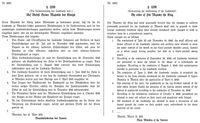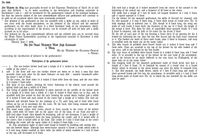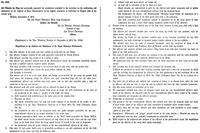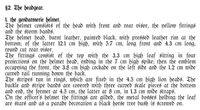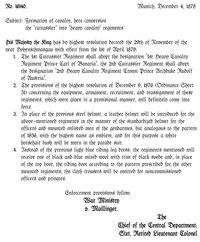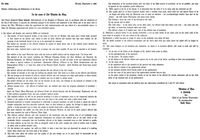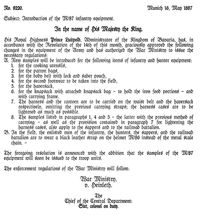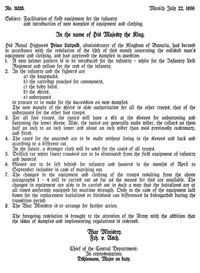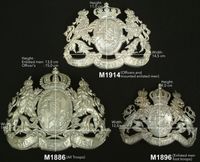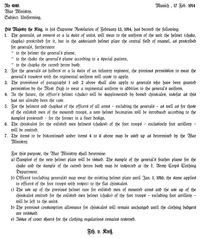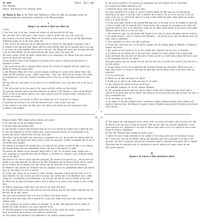The history of the Pickelhaube in the Royal Bavarian army and Landwehr
26.9.1848:
The Pickelhaube was introduced in the Kingdom of Bavaria with the AKO of 26.9.1848 by King Maximillian II for the Landwehr. Since the helmets M48 were not cheap and the military budget did not allow an immediate and complete, immediate implementation, the equipment with the "helmet in shape of the Pickelhaube" was not mandatory. Rather, it was only generally permitted to be worn in the Landwehr, although care had to be taken to ensure a uniform appearance in the units.
Due to problems of interpretation among the Landwehr officers responsible for the implementation, the king communicated again with the AKO of August 5, 1849, that the permission should extend in particular to the Landwehr artillery. A further specification was made with the AKO of June 5, 1849, with which he allowed the Landwehr cavalry to wear the helmet in the form as it was introduced for the Landwehr district command of Upper Bavaria in Munich, at the request of April 5, 1849. For parades the Landwehr fusiliers wore a white (from 1863 black), the Landwehr artillery a red and the Landwehr “Jäger“ and „Schützen“ a black horsehair plume.
24.4.1856:
The M56 pickelhaube was introduced for the gendarmes (military police at that time). However, the interim shakos were still allowed to be worn by non-commissioned officers and gendarmes on all occasions when the helmet had to be worn in accordance with regulations.
- The gendarmes on foot wore the typical spike on the helmet, which was not removable. The officers and mounted gendarmes, however, wore a screw-on spike, which could be replaced by a black horsehair bush for parades and the like.
The pickelhaube M56 had the following dimensions:
(measurement conversion according to 1870 data: 1 meter = 0.292 feet / 1 inch = 2.432 cm / 1 line = 0.203 cm)
- The helmet shell had a height of 6.5'' (15.8 cm - measured inside in the center) and was reinforced at the bottom with a pressed leather trim.
- The spike of the gendarmes on foot were 1'' 10''' (4,5 cm) high, the cross fitting was 2'' (4,9 cm). So, in total, about 3'' 10''' (9.3 cm) high. The helmets of the mounted gendarmes had a removable spike with a height of 3'' 9''' (9.1 cm).
- At the back ran a 7 line (1.4 cm) wide curved spine, approximately to the end of the leather trim.
- The hair plume worn for parades had a length of 1' 6'' (43.8 cm) and was attached to the helmet by a brass plume sleeve of only 1'' 8''' (4.1 cm) to the helmet fitting. The hair plume hung down to about the bottom of the visors.
- The chinscales were attached to the helmet with rings on 4.5 cm high lion head brackets, as on the M48 helmet.
- On the left, a metal Bavarian cockade with a diameter of about 4 cm was worn over the lion's head of the chinscales.
- The lining had 5 flaps and could be adjusted by a ribbon tucked in the center.
- The royal cipher King Maximilian II had a height of 3'' 8''' (11.1 cm - including the cross on the crown) and a width of 3'' (8.8 cm) at the bottom, and 2'' (5.8 cm) at the middle. The crown was with the cross 1'' 5''' (3,4 cm) high, the cipher 2'' 3''' (5,5 cm). There were 4 brass pins soldered to the back for mounting.
29.8.1873:
The new pickelhaube M73, whose leather helmet body was similar to the current infantry caterpillar helmet, only somewhat flatter, was introduced for the officers and mounted enlisted men of the gendarmerie.
- The helmet shell was 12.1 cm high and had a pressed leather trim like the M56.
- As an emblem they wore a similar emblem as later on the helmet M86.
- The spike was a total of 10.3 cm high. Of this, 7 cm was the spike and 3.3 cm was the cross fitting.
- The chinscales, the Bavarian cockade (diameter 3.8 cm) and their attachment as on the two previous helmets.
- At the back, a curved back spine made of 1.2 cm wide brass ran down the center of the rear visor.
- On the officers, the fittings were fire-gilded.
29.11.1878:
The pickelhauben model M78 was introduced for the heavy riders.
- This was similar to the helmet introduced by officers and mounted troops of the gendarmerie already in 1873, but according to the pattern M56 with the royal cipher of the king, who was now Ludwig II, as emblem.
- Furthermore, the heavy riders wore white horsehair plumes during parades, instead of the spike.
5.9.1886:
The Pickelhaube M86 was introduced for the entire Bavarian army.
- The helmet body had the dimensions of the Prussian dragoon helmet M87, with squared front visor and 0.8 cm wide metal trimm (officers 0.6 cm wide) around the lower edge and rear visor with rounded corners. In contrast to the Prussian helmet, which was stitched together by means of a seam under the back spine, the Bavarian helmet shell of the M86 was made of one piece of pressed leather, as good experience had been made with this manufacturing technique during the 1870/71 campaign.
- The helmet emblem of the M86 consisted of 2 upright standing crowned lions as shield holders, holding an oval shield with the 4 most important Bavarian coats of arms, all decorated with laurel tendrils. Above this, in the center, the Bavarian crown and below it a ribbon with the saying "IN TREUE FEST". Thoughts to place dates of memorable battles on the helmet, as it was the case for some Prussian regiments, were dropped due to lack of space above the emblem. The emblem of the enlisted men should be about 13 cm high and 18 cm wide; the emblem of the officers 15 cm high and 18 cm wide. However, measurements of various Bavarian helmet emblems show that the specifications were poorly met, as there are deviations of up to 2 cm.
- The cockades now followed the Prussian model. The enlisted man's cockade was 5 cm in diameter, that of the officers 5.5 cm. The Bavarian cockade was worn on the right under the chinscale.
- The spike was fluted and sat on a cross fitting that was attached to the helmet with 3 to 4 round-headed screws/splints (for officers: stars). For troops with permission to wear hair plumes, the spike was removable. Unlike the Prussian troops, however, members of Bavarian artillery regiments, just like the infantry, wore a fluted attachment spike and not a ball top.
- The officers wore hair plumes of buffalo hair, while the enlisted men wore hair plumes of horsehair. The wing adjutants, general staff, heavy horsemen and chevauleger regiments wore white hair plumes, the 4 field artillery regiments wore red hair plumes and the train (excluding medical teams) wore black hair plumes.
- At the back of the helmet ran a back spine like on the Prussian helmets.
Enlisted men emblem:
Officer emblem:
14.5.1887:
After Prussia, the infantry equipment M87 was introduced to the Bavarian military as well. This included a modified helmet for the enlisted men of the Bavarian infantry, „Jäger“, engineers and railroad battalions, which became known as the M87. As mentioned, this wasn’t really a new helmet, but consisted of the M86 helmet, which was equipped with the black chin strap, with hook fastening of the Prussian M87 instead of the chinscales. However, the enlisted men only wore this chin strap in the field and during maneuvers; during the parades or in the garrisons, the enlisted men continued to wear the chinscales.
20.10.1891:
Since the up and down slinging of the chinscale/chin strap with the chin strap M87 required the removal of the helmet, the 5th Bavarian Division was equipped with the new Prussian chin strap attachment M91 on a test period during the autumn maneuvers of 1891. Due to the positive results of these tests, the Prussian chin strap attachment M91 was also generally used in the Bavarian Army for new procurements by decision of 20.10.1891.
12.7.1896:
The Pickelhaube M96 was introduced for enlisted men of the Bavarian infantry, which was the first really new helmet model after the introduction of the M86. The helmet became lower again and the design corresponded pretty much to the Prussian model M95. This should prevent the Bavarian troops from differing significantly from the other German contingents and thus making it difficult for the enemy to draw conclusions about the strength and composition of the German armed forces.
- The overall height of the helmet was reduced to 21 - 21.3 cm. The leather shell was 9 cm and the front visor was round, as same as the Prussian example. The total weight was still around 360g.
- The total height of the spike of the enlisted man's helmets was now smooth and was attached to the helmet with a round spikebase, as in Prussia. For mounted troops the spike was only 8.4 cm high.
- The helmet emblem of the M96 was smaller analogous to the helmet and only 9 cm high and 12 cm wide on average. Because of the reduced size, it was more simple and compact, the decorative laurel tendrils of the M86 emblem were omitted.
Unfortunately, I could not find any official specifications for the M96 and M1914 emblems from that time. The dimensions are therefore average values of various measured emblems. I thank Amy Bellars and Tony Schnurr (Kaisersbunker.com) for their help and support.
- In the field and for maneuvers, the black chinstrap with the M91 attachment continued to be worn. During parades and in garrison, however, the flat chinscales were worn as before.
- The enlisted man cockade was reduced to a diameter of 4.8 cm.
- The officers' helmets were not affected by this change; from 1886 to 1914 they wore the M86 helmet, which was similar to the Prussian M87 dragoon helmet. However, the officers' helmets had a higher manufacturing quality.
20.3.1897:
As same as in the other German states, the German Imperial cockade in red-white-black (from inside to outside) was introduced for all Bavarian troops. It was worn on the right side of the helmet, the Bavarian cockade changed to the left side of the helmet.
13.2.1914:
Introduction of the M1914 helmet emblem. After the infantry had long since received a smaller helmet emblem with the M96, this should now also happen for the officers of all weapons and the mounted enlisted men. As in 1896, the objective was to minimize the distinctiveness of German troops to the enemy.
- The helmet emblem M1914 was now about 11 cm high and 14,5 cm wide on average.
Unfortunately, I could not find any official specifications for the M96 and M1914 emblems from that time. The dimensions are therefore average values of various measured emblems. I thank Amy Bellars and Tony Schnurr (Kaisersbunker.com) for their help and support.
- For generals, the enamelled central shield on the emblem of the helmet was introduced.
- In addition, all officers wore convex chinscales now. The foot troops, on the other hand, except for the foot artillery, only wore the chin strap with the M91 fastening button and no longer had chinscales.
31.3.1916:
Similar to the new helmet pattern introduced in Prussia in 1915, the entire Bavarian army was to receive a new helmet pattern, too. This was the last Bavarian spiked helmet M16. The old style helmets were allowed to be worn.
- Enlisted men of the field artillery and the train received the helmet M96.
- The red hair plumes of the Field Artillery and the black hair plumes of the Train regiments were omitted.
- All helmets received a removable spike. Only now the helmets of enlisted men and officers of the Field and Foot Artillery and the helmets of officers and non-commissioned officers of the Ordnance and Fire Brigade units received a detachable ball instead of the spike. These attachments were left in place when marching out to the field or during exercises in the garrisons.
- The chinscales were given the M91 attachment system and were now reserved for officers only. Provided the helmet cover was put on, however, they too wore the black chin strap (i.e. in the field or during maneuvers).
- The helmets of all officers, moreover, remained unchanged.
